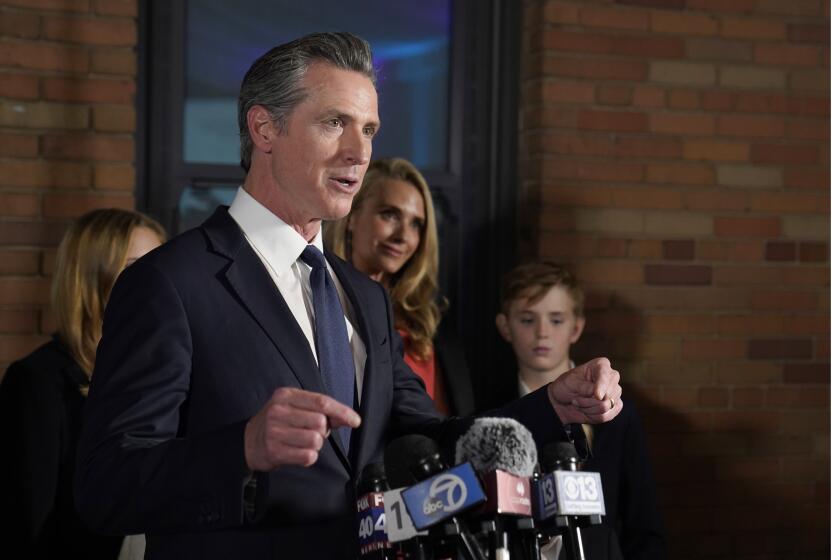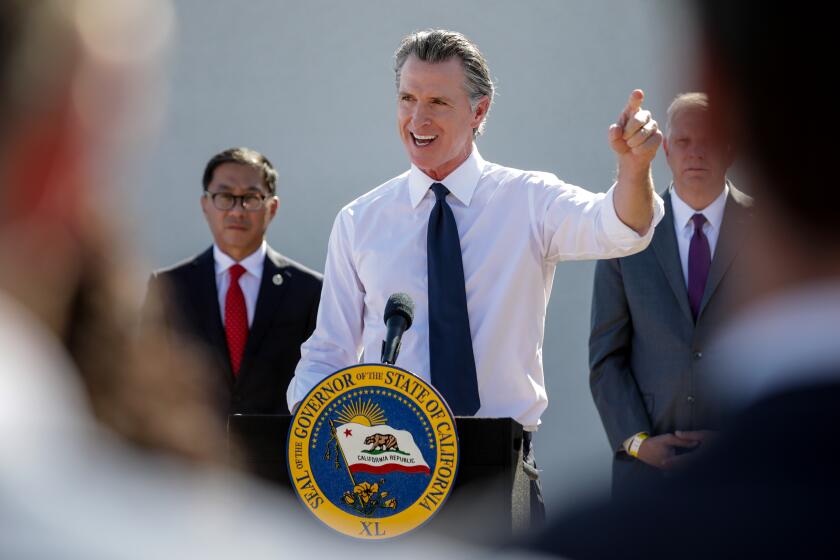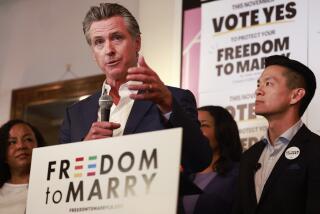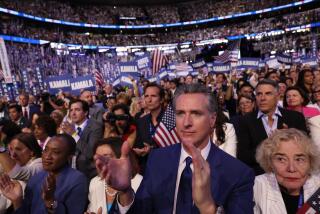Column: Newsom’s resounding win shows he didn’t even have to run a race for governor
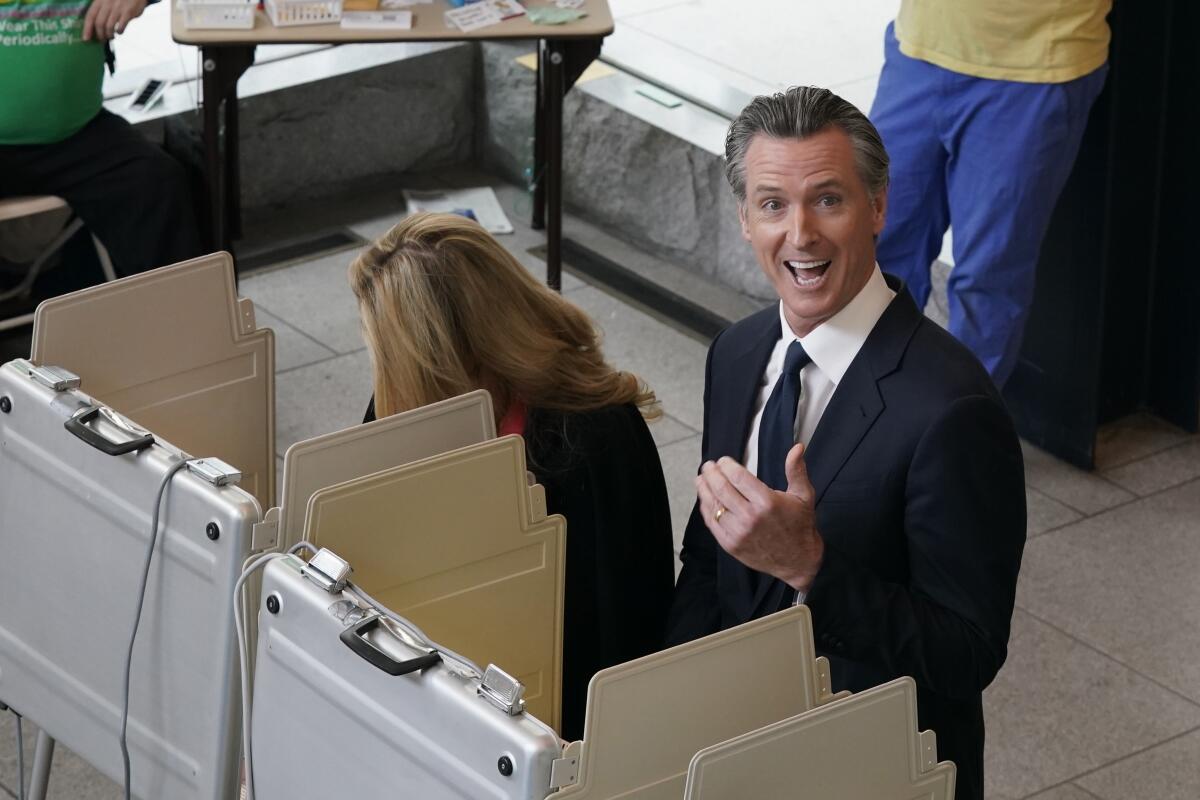
SACRAMENTO — What Gov. Gavin Newsom did was truly unprecedented. He handily won his reelection race without running.
He didn’t even ask for our votes — the first thing any candidate should do. Yet, he was reelected governor of the nation’s most populous state in a near landslide.
What does that tell us?
Answer: How weak the once formidable Republican Party has finally become in California. Its gubernatorial candidate couldn’t even mount a competitive campaign against a noncombatant.
The GOP apparently kept its record intact of not having won a statewide race since 2006.
Newsom’s opponent, state Sen. Brian Dahle, 57, a seed farmer from rural Lassen County, was potentially the best GOP gubernatorial candidate since business executive Meg Whitman lost to Democratic legend Jerry Brown in 2010.
Measured by experience in elective office, Dahle was the most qualified Republican to run for governor since then-Atty. Gen. Dan Lungren lost to Democrat Gray Davis in 1998.
But Whitman was megarich and could pour $150 million of her own money into the all-out campaign. Lungren wasn’t rich, but the GOP was healthy enough back then that donors felt he was a promising investment.
Dahle couldn’t raise enough money to hire much of a staff, let alone buy TV ads.
Newsom was rolling in campaign investors’ money. He could have run TV ads 24/7, but didn’t run any. He didn’t need to. That’s unheard of for a governor.
The incumbent was a “D” in deep-blue California and Dahle was an “R.” That’s all voters needed to know in this polarized era.
Results come in the races for California governor, attorney general and controller.
Oh, Newsom did run some TV ads, though not for himself. He appeared in an ad for Proposition 1, the ballot measure to cement abortion rights in the state Constitution. It won lopsidedly and presumably helped turn out Democratic voters, as the party planned.
The governor also was featured in an effective ad that helped defeat Proposition 30, the initiative bankrolled by ride-hailing company Lyft that would have taxed the rich to subsidize electric car purchases — and greatly helped Lyft’s drivers.
Newsom’s only real campaign event was one little-noticed debate broadcast on a Sunday afternoon as pro football games were telecast. He was practically flawless and should have pushed for an evening performance shown to a statewide TV audience.
By not campaigning on TV and on the stump, Newsom can’t claim what winners always do: a mandate for pet projects. His only mandate is to not become a Republican, although there are plenty of unfulfilled promises still left over from his 2018 election campaign.
Start with removing homeless people from the streets, housing them and treating their mental health issues and addictions.
Newsom did campaign out of state — on TV and billboards in Florida and Texas against their governors’ conservative polices on abortion and immigration. That got his name circulated across America as a national political player and a potential presidential candidate — priceless publicity for a politician, even if it is hype.
Having spent relatively little in California, Newsom ended the campaign with around $20 million stashed in his political kitty.
What does the 55-year-old governor do with that money now that he won’t be running for another state office?
He could use it to finance a ballot measure or fight one. But using money raised for a state race on a federal campaign is difficult and impractical. The federal contribution rules are much tighter.
Gov. Gavin Newsom critiques local governments for not doing more to battle homelessness. He should be helping, columnist George Skelton writes.
Still, what Newsom probably does is keep doing what he has been: running to get into position to enter the 2024 presidential race.
He certainly knows that ultimately it won’t matter even if he did promise to serve a full four-year second term as governor and has consistently insisted he has “subzero interest” in the White House.
Sure he does. He’s a politician and he’s human.
That said, I’d be surprised if Newsom runs for president in two years.
He wouldn’t run against President Biden. And if Biden doesn’t run, he probably won’t decide that until the last minute — very late for a governor to jump into the early primaries.
Newsom probably wouldn’t hesitate to compete against his old California sidekick, Vice President Kamala Harris. But she’d have the early advantage. And Newsom is young enough to wait for another race.
Anyway, it’s highly doubtful any California Democrat could win the presidency these days. We’re just too leftist for flyover country and the South.
If Newsom does have dreams of the Rose Garden, he should consider running for U.S. Sen. Dianne Feinstein’s seat in 2024. She’ll certainly retire at age 91. The Senate would provide him with a more noticeable national pulpit. And California Senate seats rarely open up for Democrats.
But that’s also unlikely. Newsom would have to surrender the last two years of his term. And governors don’t like to give up their powerful executive jobs to become one of 100 senators, especially as a freshman without seniority.
Meanwhile, all Democratic candidates, including Newsom, have two people to thank for preventing the buildup of the feared Red Wave: Donald Trump and Samuel Alito.
Trump was the GOP’s red flag that scared off Democrats and independents with his wretched behavior and lying. Alito’s the Supreme Court justice who wrote the extreme ruling that killed national abortion rights, agitating Democratic voters and giving the likes of Newsom a potent issue.
Republican politicians should finally distance themselves from the embarrassing former president. And Democrats should hope he actually runs in 2024. Rather than a red wave, there’d be a smelly sump.
More to Read
Sign up for Essential California
The most important California stories and recommendations in your inbox every morning.
You may occasionally receive promotional content from the Los Angeles Times.
